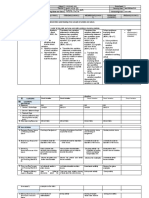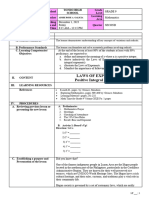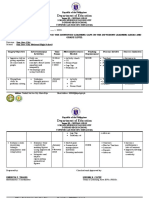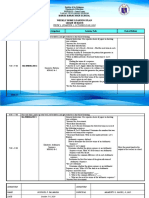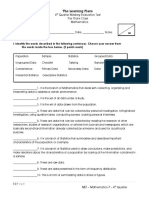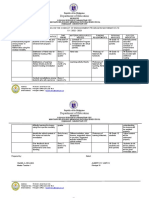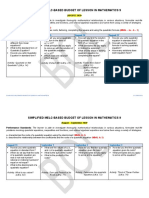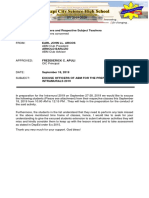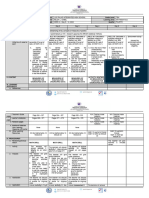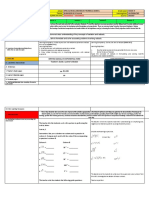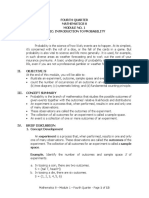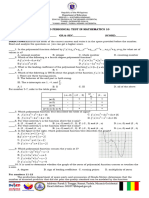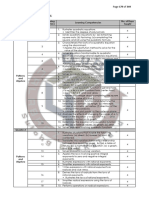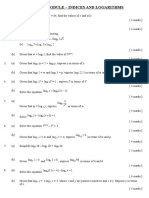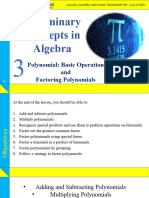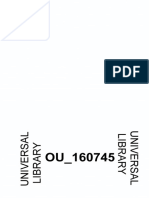GRADE 9 – MATHEMATICS
No. of Learning Delivery
Quarter MELC Learning Competencies Days Platforms
Taught TV Radio Both
Quarter 1
Identifies the degree of polynomials
1 Illustrates quadratic equations. /
Solves quadratic equations by: (a) extracting square roots; 4
2 (b) factoring; (c)completing the square; and (d) using the /
quadratic formula.
Applies the substitution method to solve for the value of the
discriminant.
Characterizes the roots of a quadratic equation using the
3 /
discriminant.
4
Describes the relationship between the coefficients and the
4 /
roots of a quadratic equation
Solves equations transformable to quadratic equations
5 /
(including rational algebraic equations).
States the steps of solving word problems.
Solves problems involving quadratic equations and rational 4
6 /
algebraic equations.
recognizes the inequality symbols and its functions
7 Illustrates quadratic inequalities /
Patterns 4
8 Solves quadratic inequalities. /
and
9 Solves problems involving quadratic inequalities. /
Algebra
10 Models real-life situations using quadratic functions. /
Represents a quadratic function using: (a) table of values; 4
11 /
(b) graph; and (c) equation.
Applies knowledge about completing the square to find the
value of h and k.
Transforms the quadratic function in general form 𝑦 = 𝑎𝑥 2 +
12 𝑏𝑥 + 𝑐 into standard form (vertex form) 𝑦 = 𝑎(𝑥 − ℎ)2 + 𝑘 and /
vice versa.
Locates and plot points on the cartesian plane.
8
Graphs a quadratic function and determine the following:
13 (a) domain; (b) range; (c) intercepts; (d) axis of symmetry; /
(e) vertex; (f) direction of the opening of the parabola.
Analyzes the effects of changing the values of a, h and k in
14 the equation 𝑦 = 𝑎(𝑥 − ℎ)2 + 𝑘. Of a quadratic function /
on its graph.
Determines the equation of a quadratic function given: (a)
15 /
a table of values; (b) graph; (c) zeros. 4
16 Solves problems involving quadratic functions. /
Quarter 2
Illustrates situations that involve the following variations: (a)
17 /
direct; (b) inverse; (c) joint; (d) combined.
Translates into variation statement a relationship between
8
18 two quantities given by: (a) a table of values; (b) a /
mathematical equation; (c) a graph, and vice versa
Patterns 19 Solves problems involving variation. /
and Applies the laws involving positive integral exponents to zero
20 4 /
Algebra and negative integral exponents.
Illustrates expressions with rational exponents.
21 Simplifies expressions with rational exponents. /
4
Writes expressions with rational exponents as radicals and
22 /
vice versa.
Illustrates the laws of rational exponents. 4
35
� No. of Learning Delivery
Quarter MELC Learning Competencies Days Platforms
Taught TV Radio Both
Derives the laws of radicals from the laws of rational
23 /
exponents.
24 Simplifies radical expressions using the laws of radicals. 4 /
25 Performs operations on radical expressions. 4 /
26 Solves equations involving radical expressions. /
4
27 Solves problems involving radicals. /
Quarter 3
Illustrates the measure of sides and angles of polygons.
Determines the conditions that make a quadrilateral a
28 /
parallelogram. 4
Uses properties to find measures of angles, sides and other
29 /
quantities involving parallelograms.
Proves theorems on the different kinds of parallelogram
30 4 /
(rectangle, rhombus, square).
31 Proves the Midline Theorem. /
4
32 Proves theorems on trapezoids and kites. /
Solves problems involving parallelograms, trapezoids and
33 4 /
kites.
34 Describes a proportion. /
Applies the fundamental theorems of proportionality to 4
35 /
solve problems involving proportions.
36 Illustrates similarity of figures. /
Proves the conditions for similarity of triangles.
SAS Similarity Theorem
SSS Similarity Theorem 8
37 /
AA Similarity Theorem
Right Triangle Similarity Theorem
Special Right Triangle Theorem
38 Applies the theorems to show that given triangles are similar. /
39 Proves the Pythagorean Theorem. /
4
Solves problems that involve triangle similarity and right
40 /
triangles.
Quarter 4
Identifies parts of a Right Triangle.
Illustrates the six trigonometric ratios: sine, cosine, tangent,
41 /
secant, cosecant, and cotangent. 8
State the properties of special right triangles.
42 Finds the trigonometric ratios of special angles. /
Geometry
43 Illustrates angles of elevation and angles of depression. /
Uses trigonometric ratios to solve real-life problems involving 12
44 /
right triangles.
45 Illustrates laws of sines and cosines. /
12
46 Solves problems involving oblique triangles. /
36


